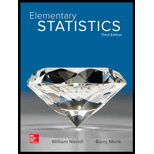
Geysers: The geyser Old Faithful in Yellowstone National Park alternates periods of eruption, which typically last from 1.5 to 4 minutes, with periods of dormancy, which are considerably longer. The following table presents the durations, in minutes, of 60 dormancy periods that occurred during a recent year.

- Construct a frequency distribution using a class width of 5, and using 55 as the lower class limit for the first class.
- Construct a frequency histogram from the frequency distribution in part (a).
- Construct a relative frequency distribution using the same class width and lower limit for the first class.
- Construct a relative frequency histogram.
- Are the histograms skewed to the left, skewed to the right, or approximately symmetric?
- Repeat parts (a)—(d), using a class width of 10, and using 50 as the lower class limit for the first class.
- Do you think that class widths of 5 and 10 are both reasonably good choices for these data, or do you think that one choice is much better than the other? Explain your reasoning.
a.
To construct:A frequency distribution using a class width of 5, and using 55 as the lower class limit for the first class.
Explanation of Solution
Given information:The following table presents the durations, in minutes, of 60 dormancy periods that occurred during a recent year.
| 91 | 99 | 99 | 83 | 99 | 85 | 90 | 96 | 88 | 93 |
| 88 | 88 | 92 | 116 | 59 | 101 | 90 | 71 | 103 | 97 |
| 82 | 91 | 89 | 89 | 94 | 94 | 61 | 96 | 66 | 105 |
| 90 | 93 | 88 | 92 | 86 | 93 | 95 | 83 | 90 | 99 |
| 89 | 94 | 90 | 95 | 93 | 105 | 96 | 92 | 101 | 91 |
| 94 | 92 | 94 | 86 | 88 | 99 | 90 | 99 | 84 | 92 |
Definition used: Frequency distributions for quantitative data are just like those for qualitative data, except the data are divided into classes rather categories.
Solution:
The class width is 5. The minimum and maximum values of the ratings are 55 and 119.9.
The table of frequency distribution is given by
| Dormancy period | Frequency |
| 55-59.9 | 1 |
| 60-64.9 | 1 |
| 65-69.9 | 1 |
| 70-74.9 | 1 |
| 75-79.9 | 0 |
| 80-84.9 | 4 |
| 85-89.9 | 11 |
| 90-94.9 | 23 |
| 95-99.9 | 12 |
| 100-104.9 | 3 |
| 105-109.9 | 2 |
| 110-114.9 | 0 |
| 115-119.9 | 1 |
b.
To construct:A frequency histogram from the frequency distribution.
Explanation of Solution
Given information:The table of frequency distribution is given by
| Dormancy period | Frequency |
| 55-59.9 | 1 |
| 60-64.9 | 1 |
| 65-69.9 | 1 |
| 70-74.9 | 1 |
| 75-79.9 | 0 |
| 80-84.9 | 4 |
| 85-89.9 | 11 |
| 90-94.9 | 23 |
| 95-99.9 | 12 |
| 100-104.9 | 3 |
| 105-109.9 | 2 |
| 110-114.9 | 0 |
| 115-119.9 | 1 |
Definition used: Histograms based on frequency distributions are called frequency histogram.
Solution:
The frequency histogram for the given data is given by
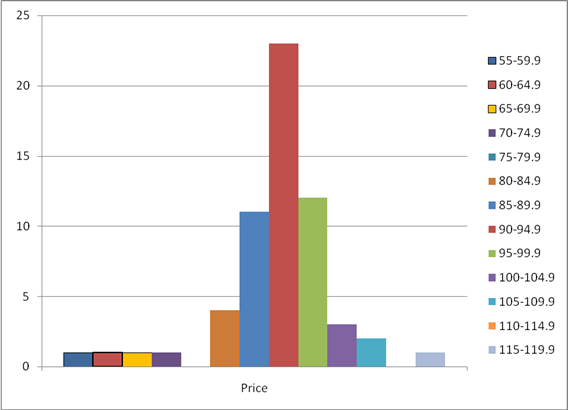
c.
To construct: A relative frequency distribution.
Explanation of Solution
Given information:The table of frequency distribution is given by
| Dormancy period | Frequency |
| 55-59.9 | 1 |
| 60-64.9 | 1 |
| 65-69.9 | 1 |
| 70-74.9 | 1 |
| 75-79.9 | 0 |
| 80-84.9 | 4 |
| 85-89.9 | 11 |
| 90-94.9 | 23 |
| 95-99.9 | 12 |
| 100-104.9 | 3 |
| 105-109.9 | 2 |
| 110-114.9 | 0 |
| 115-119.9 | 1 |
Formula used:
Solution:
From the given table,
The sum of all frequency is
The table of relative frequency is given by
| Dormancy period | Frequency | Relative frequency |
| 55-59.9 | 1 | |
| 60-64.9 | 1 | |
| 65-69.9 | 1 | |
| 70-74.9 | 1 | |
| 75-79.9 | 0 | |
| 80-84.9 | 4 | |
| 85-89.9 | 11 | |
| 90-94.9 | 23 | |
| 95-99.9 | 12 | |
| 100-104.9 | 3 | |
| 105-109.9 | 2 | |
| 110-114.9 | 0 | |
| 115-119.9 | 1 |
d.
To construct: A relative frequency histogram.
Explanation of Solution
Given information:The following table presents the durations, in minutes, of 60 dormancy periods that occurred during a recent year.
| 91 | 99 | 99 | 83 | 99 | 85 | 90 | 96 | 88 | 93 |
| 88 | 88 | 92 | 116 | 59 | 101 | 90 | 71 | 103 | 97 |
| 82 | 91 | 89 | 89 | 94 | 94 | 61 | 96 | 66 | 105 |
| 90 | 93 | 88 | 92 | 86 | 93 | 95 | 83 | 90 | 99 |
| 89 | 94 | 90 | 95 | 93 | 105 | 96 | 92 | 101 | 91 |
| 94 | 92 | 94 | 86 | 88 | 99 | 90 | 99 | 84 | 92 |
Definition used: Histograms based on relative frequency distributions are called relative frequency histogram.
Solution:
| Dormancy period | Relative frequency |
| 55-59.9 | 0.017 |
| 60-64.9 | 0.017 |
| 65-69.9 | 0.017 |
| 70-74.9 | 0.017 |
| 75-79.9 | 0.000 |
| 80-84.9 | 0.067 |
| 85-89.9 | 0.183 |
| 90-94.9 | 0.383 |
| 95-99.9 | 0.200 |
| 100-104.9 | 0.050 |
| 105-109.9 | 0.033 |
| 110-114.9 | 0.000 |
| 115-119.9 | 0.017 |
Therelative frequency histogram for the given data is given by
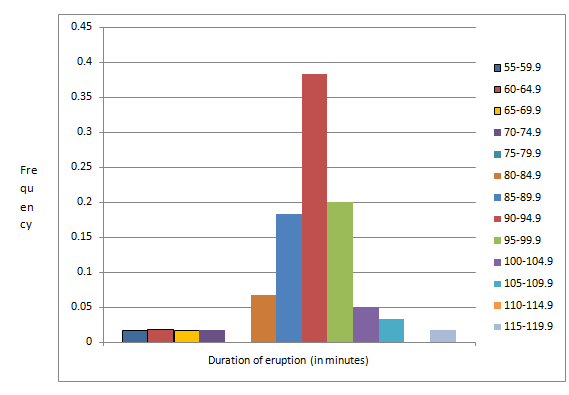
e.
To find: Whether the histograms are skewed to the right, skewed to the left , or approximately symmetric.
Answer to Problem 32E
The histogram is skewed to the left.
Explanation of Solution
Given information:The following table presents the durations, in minutes, of 60 dormancy periods that occurred during a recent year.
| 91 | 99 | 99 | 83 | 99 | 85 | 90 | 96 | 88 | 93 |
| 88 | 88 | 92 | 116 | 59 | 101 | 90 | 71 | 103 | 97 |
| 82 | 91 | 89 | 89 | 94 | 94 | 61 | 96 | 66 | 105 |
| 90 | 93 | 88 | 92 | 86 | 93 | 95 | 83 | 90 | 99 |
| 89 | 94 | 90 | 95 | 93 | 105 | 96 | 92 | 101 | 91 |
| 94 | 92 | 94 | 86 | 88 | 99 | 90 | 99 | 84 | 92 |
Definition used:
A histogram which has a long right-hand tail is said to be skewed to the right.
A histogram which has a long left-hand tail is said to be skewed to the left.
A histogram is symmetric if its right half is a minor image of its left half.
Solution:
The frequency histogram for the given data is given by
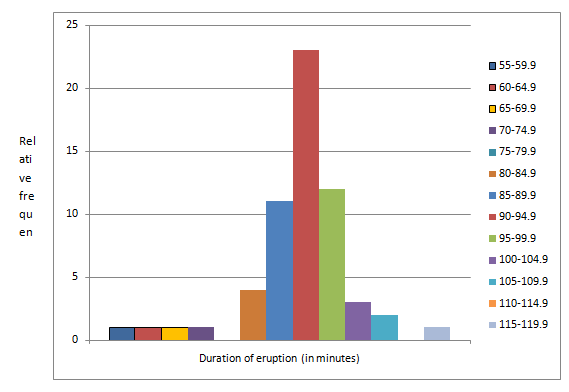
The above histogram has a long left-hand tail; therefore, it is skewed to the left.
Hence, the histogram is skewed to the left.
f.
To construct: A frequency distribution using a class width of 10, and using 50 as the lower class limit for the first class, a frequency histogram, relative frequency distribution and relative frequency histogram.
Explanation of Solution
Given information: The following table presents the durations, in minutes, of 60 dormancy periods that occurred during a recent year.
| 91 | 99 | 99 | 83 | 99 | 85 | 90 | 96 | 88 | 93 |
| 88 | 88 | 92 | 116 | 59 | 101 | 90 | 71 | 103 | 97 |
| 82 | 91 | 89 | 89 | 94 | 94 | 61 | 96 | 66 | 105 |
| 90 | 93 | 88 | 92 | 86 | 93 | 95 | 83 | 90 | 99 |
| 89 | 94 | 90 | 95 | 93 | 105 | 96 | 92 | 101 | 91 |
| 94 | 92 | 94 | 86 | 88 | 99 | 90 | 99 | 84 | 92 |
Solution:
The class width is 10. The minimum and maximum values of the ratings are 50 and 119.9.
The table of frequency distribution is given by
| Dormancy period | Frequency |
| 50-59.9 | 1 |
| 60-69.9 | 2 |
| 70-79.9 | 1 |
| 80-89.9 | 15 |
| 90-99.9 | 35 |
| 100-109.9 | 5 |
| 110-119.9 | 1 |
The frequency histogram for the given data is given by
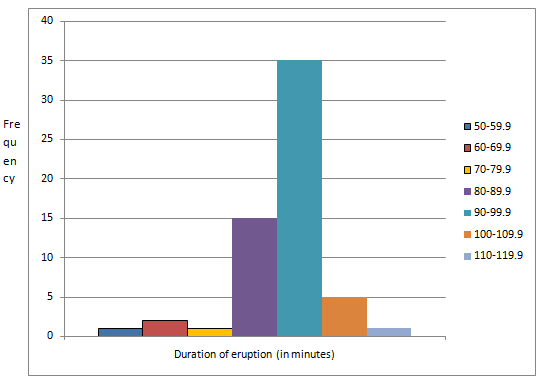
The sum of all frequency is
The relative frequency distribution table is given by
| Dormancy period | Frequency | Relative frequency |
| 50-59.9 | 1 | |
| 60-69.9 | 2 | |
| 70-79.9 | 1 | |
| 80-89.9 | 15 | |
| 90-99.9 | 35 | |
| 100-109.9 | 5 | |
| 110-119.9 | 1 |
The relative frequency histogram for the given data is given by
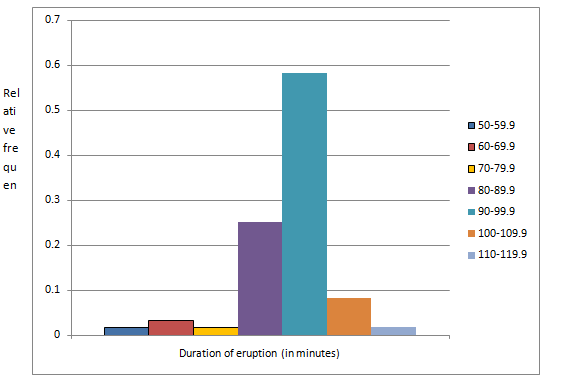
g.
To explain: Whether the good choices for the data are that class width of 5 or 10.
Answer to Problem 32E
Explanation of Solution
Given information:The following table presents the durations, in minutes, of 60 dormancy periods that occurred during a recent year.
| 91 | 99 | 99 | 83 | 99 | 85 | 90 | 96 | 88 | 93 |
| 88 | 88 | 92 | 116 | 59 | 101 | 90 | 71 | 103 | 97 |
| 82 | 91 | 89 | 89 | 94 | 94 | 61 | 96 | 66 | 105 |
| 90 | 93 | 88 | 92 | 86 | 93 | 95 | 83 | 90 | 99 |
| 89 | 94 | 90 | 95 | 93 | 105 | 96 | 92 | 101 | 91 |
| 94 | 92 | 94 | 86 | 88 | 99 | 90 | 99 | 84 | 92 |
The class width of 5 provides more appropriate level of detail in the middle of the histogram, but it is very sparse in the tail.
The class width of 10 is better in the tails, but most of the data are in only two classes.
Therefore, the distribution of class width of 5 is more reasonably good choice than class width of 10.
Want to see more full solutions like this?
Chapter 2 Solutions
Elementary Statistics ( 3rd International Edition ) Isbn:9781260092561
- Suppose that the chance that an elementary student eats hot lunch is 30 percent. What’s the chance that, among 20 randomly selected students, between 6 and 8 students eat hot lunch (inclusive)?arrow_forwardBob’s commuting times to work are varied. He makes it to work on time 80 percent of the time. On 12 randomly selected trips to work, what’s the chance that Bob makes it on time at least 10 times?arrow_forwardYour chance of winning a small prize in a scratch-off ticket is 10 percent. You buy five tickets. What’s the chance you will win at least one prize?arrow_forward
- Suppose that 60 percent of families own a pet. You randomly sample four families. What is the chance that two or three of them own a pet?arrow_forwardIf 40 percent of university students purchase their textbooks online, in a random sample of five students, what’s the chance that exactly one of them purchased their textbooks online?arrow_forwardA stoplight is green 40 percent of the time. If you stop at this light eight random times, what is the chance that it’s green exactly five times?arrow_forward
- If 10 percent of the parts made by a certain company are defective and have to be remade, what is the chance that a random sample of four parts has one that is defective?arrow_forwardQuestion 4 Fourteen individuals were given a complex puzzle to complete. The times in seconds was recorded for their first and second attempts and the results provided below: 1 2 3 first attempt 172 255 second attempt 70 4 5 114 248 218 194 270 267 66 6 7 230 219 341 174 8 10 9 210 261 347 218 200 281 199 308 268 243 236 300 11 12 13 14 140 302 a. Calculate a 95% confidence interval for the mean time taken by each individual to complete the (i) first attempt and (ii) second attempt. [la] b. Test the hypothesis that the difference between the two mean times for both is 100 seconds. Use the 5% level of significance. c. Subsequently, it was learnt that the times for the second attempt were incorrecly recorded and that each of the values is 50 seconds too large. What, if any, difference does this make to the results of the test done in part (b)? Show all steps for the hypothesis testarrow_forwardQuestion 3 3200 students were asked about the importance of study groups in successfully completing their courses. They were asked to provide their current majors as well as their opinion. The results are given below: Major Opinion Psychology Sociology Economics Statistics Accounting Total Agree 144 183 201 271 251 1050 Disagree 230 233 254 227 218 1162 Impartial 201 181 196 234 176 988 Total 575 597 651 732 645 3200 a. State both the null and alternative hypotheses. b. Provide the decision rule for making this decision. Use an alpha level of 5%. c. Show all of the work necessary to calculate the appropriate statistic. | d. What conclusion are you allowed to draw? c. Would your conclusion change at the 10% level of significance? f. Confirm test results in part (c) using JASP. Note: All JASP input files and output tables should be providedarrow_forward
- Question 1 A tech company has acknowledged the importance of having records of all meetings conducted. The meetings are very fast paced and requires equipment that is able to capture the information in the shortest possible time. There are two options, using a typewriter or a word processor. Fifteen administrative assistants are selected and the amount of typing time in hours was recorded. The results are given below: 1 2 3 4 5 6 7 8 9 10 11 12 13 14 15 typewriter 8.0 6.5 5.0 6.7 7.8 8.5 7.2 5.7 9.2 5.7 6.5 word processor 7.2 5.7 8.3 7.5 9.2 7.2 6.5 7.0 6.9 34 7.0 6.9 8.8 6.7 8.8 9.4 8.6 5.5 7.2 8.4 a. Test the hypothesis that the mean typing time in hours for typewriters is less than 7.0. Use the 1% level of significance. b. Construct a 90% confidence interval for the difference in mean typing time in hours, where a difference is equal to the typing time in hours of word processors minus typing time in hours of typewriter. c. Using the 5% significance level, determine whether there is…arrow_forwardIllustrate 2/7×4/5 using a rectangular region. Explain your work. arrow_forwardWrite three other different proportions equivalent to the following using the same values as in the given proportion 3 foot over 1 yard equals X feet over 5 yardsarrow_forward
 Glencoe Algebra 1, Student Edition, 9780079039897...AlgebraISBN:9780079039897Author:CarterPublisher:McGraw Hill
Glencoe Algebra 1, Student Edition, 9780079039897...AlgebraISBN:9780079039897Author:CarterPublisher:McGraw Hill Holt Mcdougal Larson Pre-algebra: Student Edition...AlgebraISBN:9780547587776Author:HOLT MCDOUGALPublisher:HOLT MCDOUGAL
Holt Mcdougal Larson Pre-algebra: Student Edition...AlgebraISBN:9780547587776Author:HOLT MCDOUGALPublisher:HOLT MCDOUGAL Big Ideas Math A Bridge To Success Algebra 1: Stu...AlgebraISBN:9781680331141Author:HOUGHTON MIFFLIN HARCOURTPublisher:Houghton Mifflin Harcourt
Big Ideas Math A Bridge To Success Algebra 1: Stu...AlgebraISBN:9781680331141Author:HOUGHTON MIFFLIN HARCOURTPublisher:Houghton Mifflin Harcourt Trigonometry (MindTap Course List)TrigonometryISBN:9781305652224Author:Charles P. McKeague, Mark D. TurnerPublisher:Cengage Learning
Trigonometry (MindTap Course List)TrigonometryISBN:9781305652224Author:Charles P. McKeague, Mark D. TurnerPublisher:Cengage Learning



